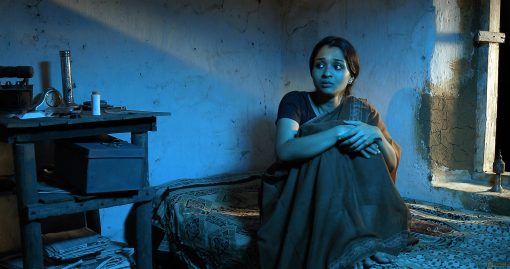
Light is often seen as the symbol of hope and growth and positivity but what if the same light becomes evil? Light in The Room (Ottamuri Velicham) recognises the historical gravity of marital rape and presents a scathing attack on the issue.
At the heart of the film is a debate between Nature and Culture which the film interacts with in several ways. Sudha, the dainty-bride, stands for innocence and Nature. A bright-eyed bride comes into a new household. There’s a delightful wonder in her eyes as she explores the trees, the streams, and the flowers. Even the cuckoo responds to her voice! The antithesis to her is her husband, Chandran, a hot-headed electrician in the pursuit of invention, who stands for reason, and “scientific temper”. But Nature also has its moments of fury. This is what the film shows powerfully. We are told that once a land of economic prosperity – with factories, shops and a thriving population — the village is now a withered, isolated forest. This is how the film comments on the man-made encroachment of forests. In a parallel stream in the film, the household suffers the menace to the vegetation by a wild boar. However, in a sharp scene, Sudha is beaten and dragged home by her husband as the wild boar watches from a distance. Who is the real beast? – the film seems to ask.
Light in the Room shows how the threat to women’s safety does not come from the outside, but from within the home. The centred silence around marital rape in the film shows how events of extraordinary violence draw from registers of the ordinary. The violence on Sudha is beastly and yet normalised. Her mother-in-law justifies Chandran’s behaviour owing to years of violent conditioning inherited from his father in the same vein as she seeks to pass-down generational trauma to her. Light in the Room, thus, presents a timely dialogue on toxic masculinity and patriarchy where gendered violence under the garb of “tradition” is not acceptable anymore.
The raging eyes of Sudha remind one of Aarti (Rekha) from Khoon Bhari Maang, – the only other wronged wife in the history of Hindi Cinema who dared to take revenge, or Tatri, the Namboodiri wife in twentieth-century Kerala who became a prostitute to avenge against her husband’s infidelity.
Although the sounds in the film affirm to the natural forest imagery on screen, much like any conventional film, it is in cinematography where the technical prowess of Rahul Nair, an engineer graduate and director, is displayed. Contrary to a “festival-film” template of long continuous shots, the director takes the harder, more labour-intensive task of taking short and brisk shots, which build up the suspense. Each scene of the film is pregnant with premonition. We shudder, thudder, flinge, and cringe with Sudha. After the film concluded with statistical reports of marital rapes in India, I broke down. Light in the Room may be a difficult film to watch, but it is a film that needed to be made.
Watch the trailer of the film here.
Read more:
The Mahatma on Celluloid
Sui Dhaaga: Weaving Deception
The Self-Reflexive Cinema of Rituparno Ghosh




